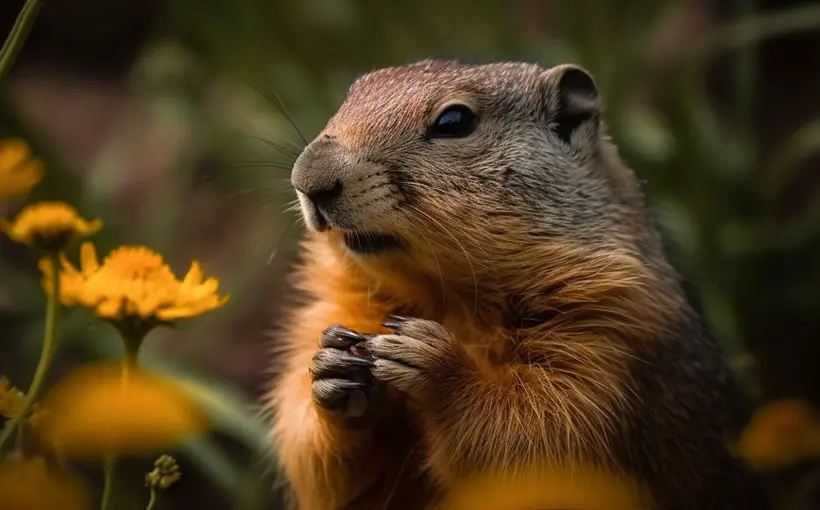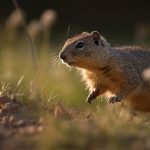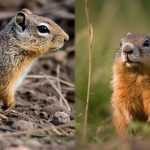What Does Gopher Eat? A Comprehensive Guide to Gopher Diet
Gophers are medium-sized burrowing rodent species that live underground. These creatures are commonly found in North and Central America areas with loose, sandy soil. They can live in meadows, deserts, grassland, and wooded areas.
But what does gopher eat? Gophers feed on an array of plant materials. They eat the roots, seeds, stems, leaves, bulbs, and even tubers. However, their food choices may vary based on seasonality, food availability, risk of predation, and taste.
While gophers can eat nearly every plant matter, understanding their diet types is vital for effective pest control. This is because you get to know which plants to grow in your garden and those to avoid to keep these pests away.
Want to know more? Please read this guide to discover everything about gopher feeding habits, nutritional needs, and methods of finding food.
What Are Gopher Dietary Habits
Gophers, commonly known as pocket gophers, are strict herbivores or vegetarians. So, unlike other groups of rodent species like rats and mice, the diet of gophers comprises only plant materials and no animal flesh.
Besides the roots, gophers can eat bulbs, tubers, leaves, stems, and other fleshy parts of plants they come across while digging underground. In addition, they can feed on grasses, flowering plants, seeds, shrubs, and tree barks.

Occasionally, these rodents may eat carrots, lettuce, Brussel sprouts, broccoli, cabbage, onions, garlic, peas, and other vegetables. So, they are not particularly picky eaters.
While gophers are strictly vegetarians, they may accidentally ingest small invertebrates or insects mixed in with plant roots. Therefore, they can be considered omnivorous, although they don’t actively hunt or consume insects.
How Do Gophers Look for Food?
Since gophers are burrowing rodent species, you will find them digging for food underground. They usually forage for food by digging complex tunnels. In addition, these animals use their strong sense of smell to track down food sources underground.
Gophers also have broad feet and very sharp claws they use to navigate through the soil to find food. More so, they are equipped with sharp incisors for cutting through the tubers or roots.

Once they locate food, gophers usually collect and store as much as they can in their underground burrows. They typically create storage chambers in their burrows to ensure other animals do not spoil or steal the food.
This caching habit of these rodent species ensures they have enough food when resources are scarce, like during drought or winter.
What Are Gophers Favorite Foods?
Gophers consume a wide range of plant materials they find, making them opportunistic feeders. Below is a list of gopher favorite foods.

Roots
These garden pests love to eat the fleshy roots of plants and trees. They love the roots of herbaceous plants like potatoes, carrots, onions, lettuce, spinach, alfalfa, and beets. Plants with more fibrous roots, like maize, bananas, and wheat, are not their favorites.
Grasses
Gophers also love to graze on various kinds of grass above ground close to their burrow systems. In particular, they enjoy feeding on Kentucky bluegrass, Bermuda grass, timothy grass, needle and thread grass, scouring rush, and mosquito grass.
Tubers
Gophers enjoy eating the tubers of sweet potatoes as they are high in sugar and essential nutrients. Other tubers that these rodents love to eat are yams and potatoes.
Seeds
Gophers love feeding on seeds of different plants, including alfalfa, sunflower, corn, beans, and peas, if available. They simply pull the seeds down to their burrows.

Bulbs
Flower bulbs are a tasty treat for gophers. In addition, these pests love to feast on underground tulip bulbs, crocus bulbs, and iris bulbs. However, they don’t eat daffodils and hyacinth bulbs. They typically shoulder them aside instead.
Shrubs
Last but not least, these rodents love feeding on above-ground plant parts like shrubs. Gophers often prefer feeding on the roots of shrubs like boxwood bushes, azalea bushes, rose bushes, and juniper bushes.
Prickly Pear Cactus
Gophers love this plant for its succulent nature, as it provides the water they need in their diet. Besides the flowers, they also eat spiny plates and fruits.
What Are The Seasonal Variations in Gopher Diets and Food Availability
Gopher seasonal variations play a major role in determining what these rodent species eat at different times of the year. For example, these pests mainly eat fruits and vegetables like pears, blueberries, green beans, and corn in the summer.

They also eat fruits, flowers, and vegetables during the spring. However, their favorite springtime snacks are grasses, tree buds, dandelions, mushrooms, and clover.
In the winter season, gophers eat the foods stored in their burrows since food is scarce at this time of the year. They also eat roots, shrubs, and tubers a lot.
Conversely, these rodents mainly feed on vegetables during the fall, including carrots, onions, radishes, potatoes, and lettuce.
Nutritional Needs of Gophers
The diet of gophers should be rich in vitamins, minerals, carbohydrates, fat, proteins, fiber, and water content. As with humans, a balanced diet is essential for gophers as it helps:
- Boost their immunity
- Extend their lifespan up to 6 years in captivity
- Support improved digestion
- Keep the fur and teeth healthy
- Strengthen their bones
- Provide enough energy for growth
- Prevent obesity problems
What Is The Role of Different Nutrients in Gopher’s Health & Behavior
Different nutrients usually have specific roles in the health and behavior of your gopher. These include:

Proteins
Gophers need protein in their daily diet for muscle growth and development. Protein also gives them the energy they need for daily activities, like foraging.
Fats and Carbohydrates
Fats and carbohydrates are an essential part of a gopher’s healthy diet. They are the primary energy source for these garden pests, supporting their physical activities and bodily functions.
Fiber
A gopher’s balanced diet should also consist of soluble and insoluble fiber. This nutrient improves stool quality and colon health while promoting your rodent’s gut health.
Vitamins and Minerals
The primary role of vitamins and minerals in your gopher’s diet is to protect them from diseases by enhancing their immunity. In addition, they may help in maintaining strong bones and regulating hormones.
Water
Gophers need water to stay hydrated and maintain optimal body temperature. Water also helps these backyard pests with enhanced digestion and proper absorption of nutrients.
Comparing Gopher’s Nutritional Needs with Those of Related Species
Gophers are a group of small rodent species. Therefore, they are closely related to rats, mice, squirrels, chipmunks, beavers, groundhogs, and porcupines.
Generally, the gopher nutritional needs are the same as most rodent species. Their diet comprises protein, carbohydrates, fat, water, fiber, vitamins, and minerals.

Like gophers, most rodent species consume various plant materials, including seeds, fruits, and vegetables, to meet their nutritional requirements. The only difference is what they eat.
While gophers are strict herbivores, their related species, like rats, chipmunks, squirrels, and mice, are omnivores. However, like gophers, groundhogs, beavers, and porcupines are also herbivores.
Different Methods of Finding Food
Similar to other rodent species, pocket gophers use various methods to locate food. They include the following:

Smelling
Like other rodents, gophers have a powerful sense of smell. This allows them to detect food scents from the surroundings, even when concealed.
Burrowing
Additionally, these backyard pests have sharp claws and teeth. This enables them to burrow or dig into the soil to find food sources.
Foraging
Gophers don’t hunt for animals to eat, like mice and rats. Instead, they forage for food underground and then store it in their burrow systems for later consumption.
When consuming their food, gophers and their related rodent species do it from inside their burrows. They have sharp incisors that quickly bite through most plant materials and teeth for grinding the food.
Factors Influencing Gopher Food Choices
While gophers can consume nearly all plant materials, several factors affect their food choices. Check them out.

Soil Types
Typically, gophers prefer to find food sources in areas with loose, sandy soil. This is because this type of soil is easy to burrow and move.
Food Availability
Gophers are not picky eaters. Therefore, they often eat the readily available food in their environment. It does not matter if it’s not their favorite.
Taste
Like humans, gophers and other rodent species also have taste buds. They generally love sweet foods. As such, they cannot eat daffodils and most allium because of their bitter taste.
Risk of Predation
When a particular food is located where predators hang out, gophers will avoid eating the food. This is to minimize the risk of getting attacked.
Season
Depending on the season, the food choices of gophers and other rodent species may also change. They eat different foods in summer, spring, fall, and winter.
Comparing Gopher Feeding Behaviors With Those Of Other Rodent Species
The feeding behaviors of gophers and related rodent species are almost alike. For instance, just like gophers, other rodent species, including the rats and mice use their strong sense of smell to find food. Also, they get their food through burrowing and foraging.

However, some rodent species like the rats, chipmunks, and squirrels usually hunt insects and other small animals. Gophers don’t hunt since they are herbivores.
Gophers are known for their destructive burrowing behavior and can cause significant damage to your yard. If you’re interested in learning more about gophers, you might want to check out our articles on what gophers look like and prairie dog vs gopher. Our piece on what gophers look like provides an in-depth look at their physical characteristics, while our article on prairie dog vs gopher offers a comparison between these two species.FAQs
Below we will respond to the commonly asked questions about what does a gopher eat.
Q: Do gophers eat meat?
No. All gopher species are herbivores and live strictly on plant matter. Also, their sharp incisors are not adapted for tearing flesh but for cutting through rigid plant material.
Q: What do baby gophers eat?
Baby gophers don’t eat solid foods for the first few weeks after birth. Instead, these pups usually rely on their mother’s milk for nutrition. After about 3 weeks, they start eating solid foods like fruits and vegetables.
Q: How much do gophers eat in a day?
Generally, these rodent species consume approximately 60% of their body weight daily in food. However, this amount may vary based on food availability, age, activity level, and sex of the gopher.
Conclusion
The diet of a gopher strictly consists of plant matter alone but varies based on seasons and food availability. However, these rodent species have their favorite foods, including grasses, shrubs, and roots. Also, they have similar nutritional needs and feeding behaviors as their related rodent species.
That said, understanding what they eat is critical to effectively control and manage these pests. Simply, it can help pest control companies develop safe and sustainable ways to regulate gopher populations.
However, more research on non-chemical gopher control methods and pest prevention is needed. These methods should take into account the gopher’s natural sources.
Having said that, you could plant gopher-resistant plants like daffodils, use raised garden beds, or install gopher traps. Trapping and hand baiting can also help control these pests.
The above methods may prevent these pests from damaging your lawns or gardens. Alternatively, you could consult wildlife management for more prevention tips.




